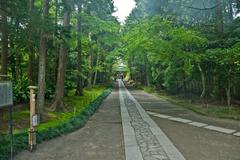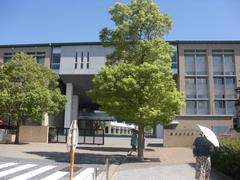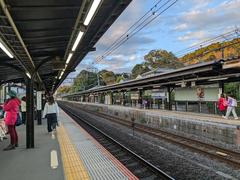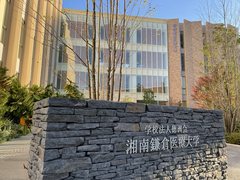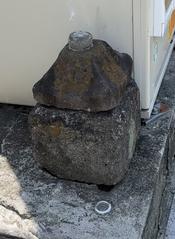
Gokurakuji Station Visiting Hours, Tickets, and Kamakura Historical Sites Guide
Date: 03/07/2025
Introduction
Gokurakuji Station, set in the historic city of Kamakura, Kanagawa Prefecture, offers not only a practical gateway to the region’s most revered historical sites but is itself an attraction, celebrated for its well-preserved early 20th-century wooden architecture. Originally established in 1904, Gokurakuji Station on the Enoshima Electric Railway (Enoden) line exudes nostalgic charm, serving as a living testament to Kamakura’s enduring cultural legacy (Kamakura Rakuan Hanare). Its proximity to major heritage temples, scenic beaches, and local festivals ensures that every visit is rich in both history and contemporary cultural experiences.
This guide provides detailed information on the station’s visiting hours, ticketing, accessibility, transportation options, nearby attractions, photography tips, and responsible tourism practices. Whether you’re a history buff, a nature enthusiast, or a cultural explorer, this article will help you plan a rewarding journey through Kamakura, using Gokurakuji Station as your starting point (Japan Travel; Kamakura City Tourist Information Center).
Table of Contents
- Introduction
- Historical and Architectural Heritage
- Cultural and Popular Significance
- Visiting Hours, Tickets, and Facilities
- Getting to Gokurakuji Station
- Responsible Tourism and Etiquette
- Nearby Attractions and Seasonal Highlights
- Transportation Options from Tokyo and Beyond
- Frequently Asked Questions (FAQ)
- Visuals and Interactive Media
- References and Further Reading
Historical and Architectural Heritage
Gokurakuji Station stands as one of Kamakura’s oldest and most atmospheric railway stations. The distinctive wooden station building, featuring traditional Japanese tiled roofing and exposed timber beams, has survived modernization, offering visitors a glimpse into early 20th-century railway architecture (Kamakura Rakuan Hanare). The station’s preservation underscores Kamakura’s commitment to maintaining its historical landscape, even as the rest of Japan’s railway system has rapidly modernized.
Cultural and Popular Significance
Role in Kamakura’s Community
More than a mere transit hub, Gokurakuji Station is deeply woven into the fabric of local life. It serves as the gateway to the tranquil Gokurakuji district and its renowned Zen temple, founded in 1259. The station is a focal point during local festivals such as the annual Menkake Procession and has appeared prominently in Japanese media, including the acclaimed film “Our Little Sister (Umimachi Diary)” (Sparkle Travel).
Cinematic and Literary Connections
Gokurakuji Station’s charming retro setting has made it a popular backdrop for films, dramas, and anime, further cementing its place in the hearts of fans and travelers alike. Its appearances in works like “Our Little Sister,” the anime “Elfen Lied,” and the manga “Minami Kamakura High School Girls Cycling Club” have turned it into a pilgrimage site for pop culture enthusiasts (en.wikipedia.org).
Visiting Hours, Tickets, and Facilities
Station Hours and Train Frequency
- Operating Hours: Daily, approximately 5:00 AM to 11:00 PM, in line with Enoden train schedules.
- Train Frequency: Every 12–15 minutes during peak hours; every 20 minutes off-peak. Schedules may vary on weekends and holidays.
Ticketing
- Single-Ride Tickets: About ¥220 from Kamakura Station to Gokurakuji Station (as of July 2025).
- IC Card Compatibility: Suica and Pasmo accepted.
- Day Pass: The Noriorikun 1 Day Pass (¥800 for adults, ¥400 for children) offers unlimited Enoden rides for a day (Japan Travel).
Station Facilities
- Platform: 1 island platform serving two tracks.
- Access: Direct entry via a gentle ramp; ground-level platform enhances accessibility.
- Staffing: Staffed during daytime, especially weekends/holidays; manual gates available for assistance.
- Amenities: Covered benches, public restrooms, beverage vending machines, bilingual signage.
- Luggage: No coin lockers on-site; storage available at Kamakura and Fujisawa stations.
- Accessibility: Wheelchair-friendly layout, though direct train boarding may require assistance.
Getting to Gokurakuji Station
From Tokyo and Major Hubs
- JR Yokosuka Line: Direct from Tokyo Station to Kamakura Station (approx. 1 hour; ¥950).
- JR Shonan Shinjuku Line: Direct from Shinjuku Station to Kamakura Station (approx. 1 hour; ¥950).
- Odakyu Railway: Odakyu Enoshima Kamakura Free Pass offers round-trip from Shinjuku plus unlimited Enoden rides (¥1,640; longer travel time) (Japan Guide).
From Kamakura Station
- Take the Enoden line (toward Fujisawa); Gokurakuji Station is the fourth stop (approx. 7 minutes).
Local Options
- City Buses: Serve more remote temples and shrines.
- Taxis: Available at major stations.
- Rental Bicycles and Walking: Many attractions within walking distance; bicycle rentals near Kamakura Station (Living Nomads).
From Airports
- Haneda: Keikyu Line to Yokohama; transfer to JR Yokosuka Line.
- Narita: JR Narita Express to Yokohama; transfer to JR Yokosuka Line.
Responsible Tourism and Etiquette
Kamakura’s historical and spiritual significance calls for respectful travel:
- Preserve Cleanliness: Use available waste bins; do not litter.
- Photography: Avoid photographing staff or residents without permission; photography is prohibited inside Goryo Shrine (matcha-jp.com).
- Noise: Maintain quiet, especially during early morning/late evening hours.
- Dress Modestly: Especially when visiting temples and shrines.
- Sustainability: Visit during off-peak hours, use public transport, and support local businesses (responsible-tourism.jp).
Nearby Attractions and Seasonal Highlights
Key Attractions
- Gokurakuji Temple: A 2-minute walk from the station, this tranquil Zen temple, founded in 1259, is known for its peaceful gardens and spiritual resonance (kamakurainfo.net).
- Hours: 9:00 AM – 4:30 PM
- Admission: Voluntary donation
- Joju-in Temple: Famous for its hydrangea path and panoramic coastal views. Open 8:00 AM – 5:00 PM; free admission.
- Goryo Shrine: Celebrated for summer festivals and hydrangea displays; photography prohibited inside shrine grounds.
- Yuigahama Beach: A 10–15 minute walk, great for swimming, surfing, and sunsets. Hosts the Kamakura Fireworks Festival (kamakura-rakuanhanare.com).
- Hasedera Temple: Accessible via Hase Station (one stop from Gokurakuji), renowned for hydrangeas and bay views (travelynotes.com).
- Kosoku-ji Temple: Quieter, with seasonal flowers and tranquil grounds.
- Kamakura Seaside Park (Inamuragasaki): Scenic headland with views of Mount Fuji and Enoshima.
- Komachi Dori Shopping Street: Near Kamakura Station, lively with shops, cafes, and regional specialties.
Seasonal Highlights
- Spring: Cherry blossoms at temples and along the Enoden line.
- Early Summer (June): Hydrangea season, especially at Joju-in and Hasedera.
- Summer: Kamakura Fireworks Festival at Yuigahama Beach (July 18, 2025).
- Autumn: Brilliant foliage at temples such as Gokuraku-ji and Kosoku-ji.
- Winter: Plum blossoms and peaceful temple visits.
Transportation Options from Tokyo and Beyond
- From Tokyo: JR Yokosuka or Shonan Shinjuku Line to Kamakura, then Enoden line to Gokurakuji.
- From Haneda/Narita Airports: Connect via Yokohama and JR Yokosuka Line.
- Day Passes: Enoshima Kamakura Free Pass and Hakone Kamakura Pass recommended for extensive sightseeing (japan-guide.com).
Frequently Asked Questions (FAQ)
Q: What are the station’s operating hours?
A: Gokurakuji Station operates from around 5:00 AM to 11:00 PM.
Q: How much is the fare from Kamakura to Gokurakuji?
A: About ¥220 one way; day passes are available.
Q: Are IC cards accepted?
A: Yes, both Suica and Pasmo are accepted.
Q: Is the station accessible for wheelchair users?
A: The station is ground level with a gentle ramp; staff assistance is available as needed.
Q: Is there luggage storage?
A: No coin lockers at Gokurakuji; use Kamakura or Fujisawa stations.
Q: Are guided tours offered?
A: Yes, particularly during hydrangea and festival seasons. Check with the Kamakura City Tourist Information Center.
Q: Is Gokurakuji Temple open during renovations?
A: The temple may be closed for renovations from July 2025 to March 2027 (visit.trip-kamakura.com). Confirm before your visit.
Q: Is photography allowed?
A: Generally yes, but not inside Goryo Shrine.
Visuals and Interactive Media
- High-quality images of Gokurakuji Station’s wooden building, Enoden trains, temples, hydrangea paths, and cherry blossoms.
- Alt tags should use keywords like “Gokurakuji visiting hours” and “Kamakura historical sites.”
- Interactive maps and virtual tours are available on tourism websites.
References and Further Reading
- Kamakura Rakuan Hanare
- Sparkle Travel
- kamakurainfo.net
- Japan Guide
- Kamakura City Tourist Information Center
- Enoshima Electric Railway Official Website
- matcha-jp.com
- Living Nomads
- travelynotes.com
- responsible-tourism.jp
- unwto.org
Final Tips and Call to Action
Gokurakuji Station is far more than a railway stop—it’s a portal into Kamakura’s storied past, living traditions, and natural beauty. From the famed Zen temple and seasonal floral displays to cinematic backdrops and local hospitality, this area rewards explorers seeking both tranquility and cultural depth.
Plan ahead by checking up-to-date train schedules and temple hours. For real-time updates, travel tips, and exclusive guides, download the Audiala app and follow us on social media. Experience Kamakura’s hidden gems, honor local customs, and create lasting memories at Gokurakuji Station and its enchanting surroundings.


